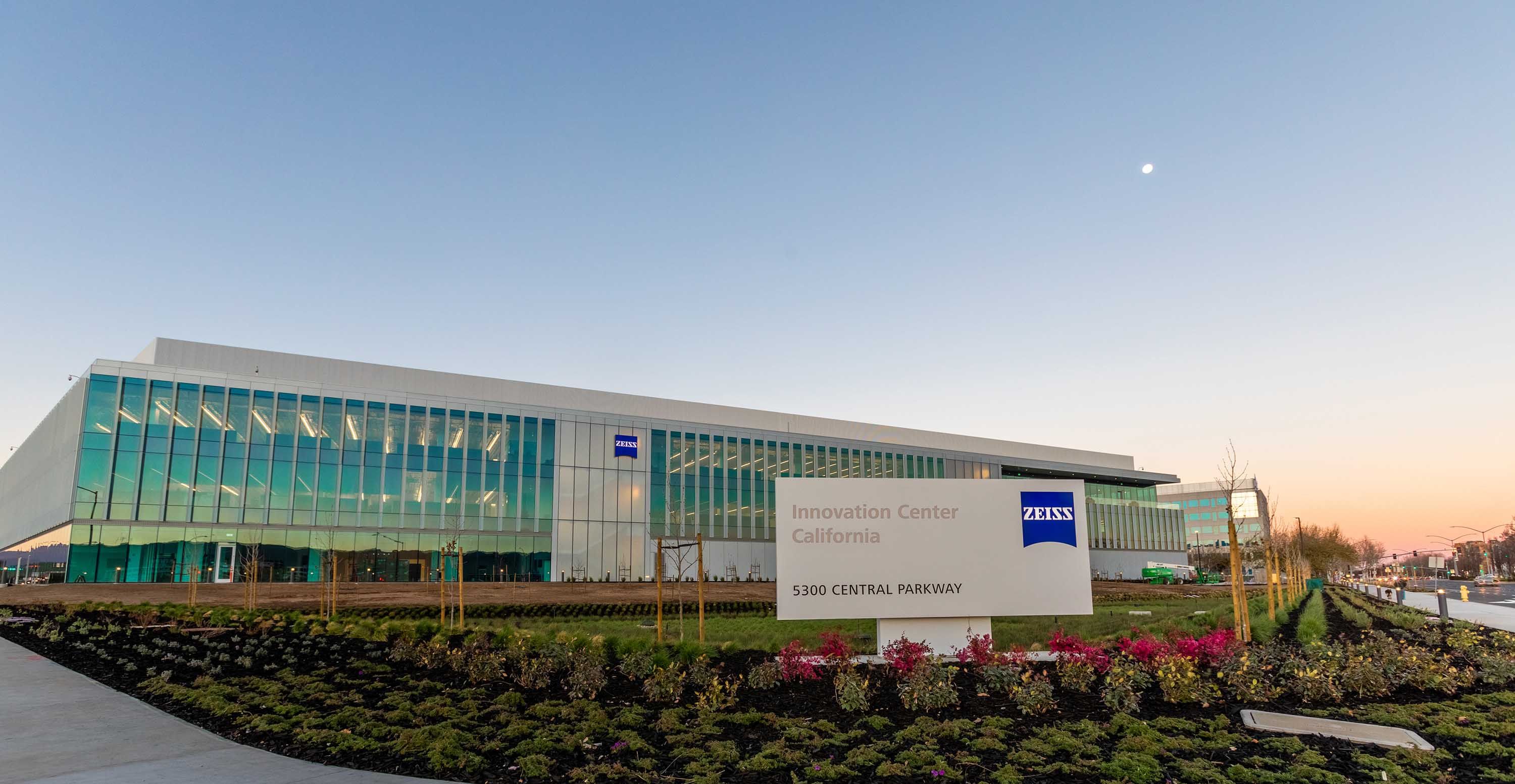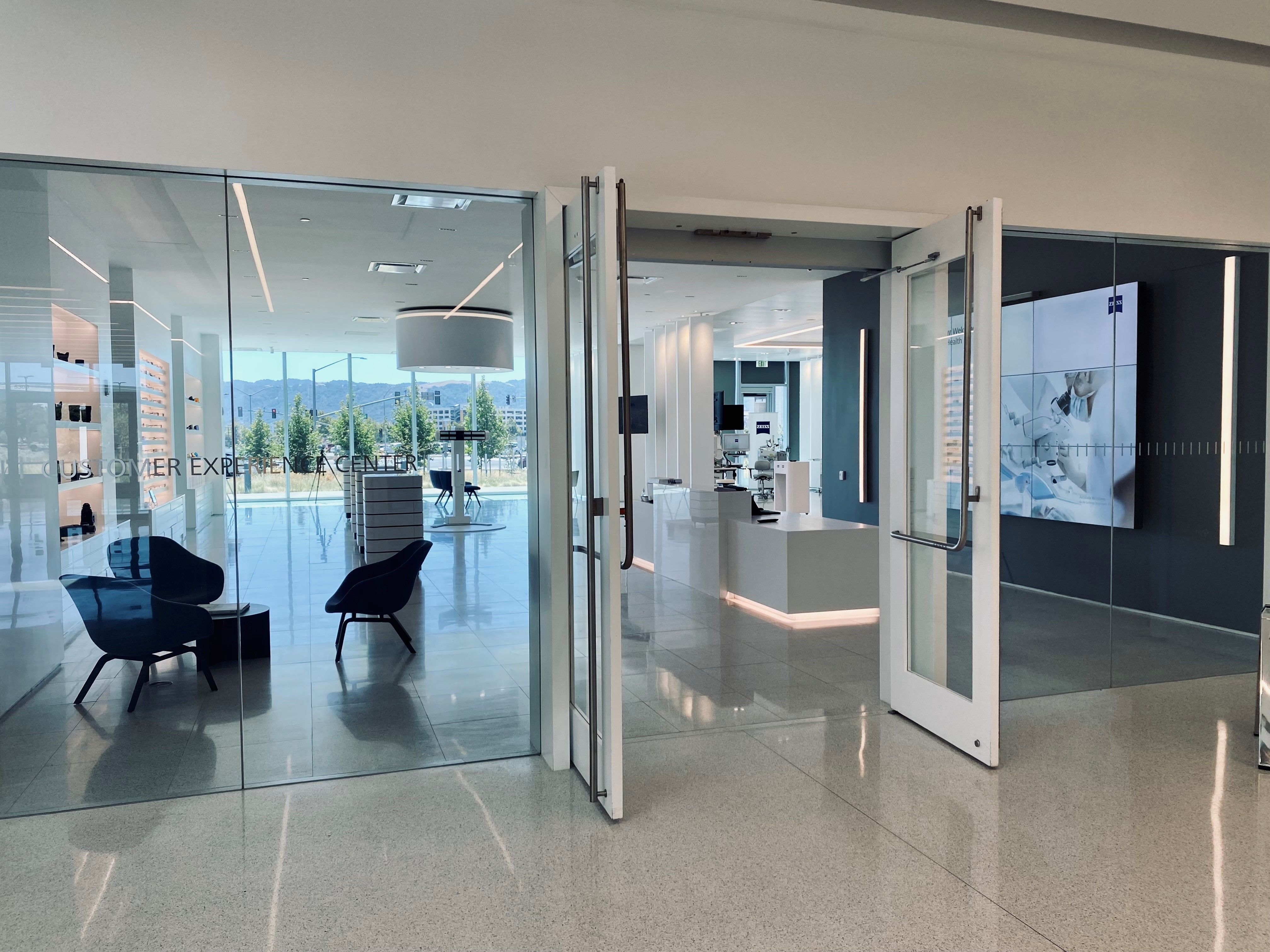Article
Taking device technology into the digital age
Author(s):
Zeiss parlays technology into standardization for ophthalmologists and their patients
The Zeiss Innivation Ceter and company headquarters in Dublin, California.

With the scenic hills of northern California as a backdrop, Carl Zeiss Meditec, Inc, recently opened its new
Zeiss Medical Technology headquarters in Dublin, 35 miles east of San Francisco. The company hosted the media for an interactive discussion about its digital integrated workflow solutions in its state-of-the-art customer experience center, which brings engineers, investigators, and sales and service teams under 1 roof.
The Zeiss Innovation Center and U.S. Medical Headquarters marks a $180 million investment, opened on March 31, 2021, and can accommodate about 700 employees. Its location is convenient to San Francisco, Oakland and San Jose.
The Zeiss Innovation Center’s R&D efforts focus primarily on digital solutions and scientific and industry partnerships spanning disciplines and technologies – key drivers behind the company’s decision to locate the center in the Bay Area.
Zeiss recently hosted the media for an interactive discussion about the company’s digital integrated workflow solutions in its state-of-the-art Customer Experience Center, which brings engineers, researchers, and sales and service teams under one roof.
The center features an Innovation Lab demonstrating the company’s several Zeiss workflows. These include:
- Cataract Workflow – ZEISS solutions enhance the efficiency and clinical outcomes for cataract procedures.
- Corneal Refractive Workflow – ZEISS solutions help streamline the refractive workflow with a digital connected infrastructure and improve efficiency with the right solution for any eligible patient.
- Retina Workflow – ZEISS solutions support both routine and complex patient management decision processes by combining premier imaging and at-a-glance history with interactive analysis, for a more efficient, worry-free and cost effective workflow.
- Glaucoma Workflow – ZEISS solutions support complex disease management by integrating critical data points necessary to make accurate decisions on treatment paths and providing at-a-glance history and progression trends with interactive analysis.
- Tumor Workflow - Combining three leading technologies, ZEISS solutions support surgeons and intraoperative teams over several steps of the surgical workflow in delivering brain tumor treatment. It is important to note that standard of care does not imply change in clinical practice. The Zeiss Tumor Workflow is a concept that includes Zeiss KINEVO 900, Zeiss CONVIVO and Zeiss INTRABEAM 600.
The Zeiss Customer Experience Center features an Innovation Lab demonstrating the company’s several Zeiss workflows.

Zeiss CEO Euan S. Thomson, PhD, president of ophthalmic devices and head of the Digital Business Unit, offered an overview highlighting the company’s strategy in ophthalmology. “We are very proud of what we have achieved and believe it is a differentiator from our competitors,” he said.
For the company, the COVID-19 pandemic shifted the way it approached business, with new constraints and restrictions that would change the way business is done forever. It also provided an opportunity, even although it would not be a money-making venture. “We engaged with customers to be prepared for the reopening of the industry and prepare for the new normal,” Thomson explained.
For example, the company started to use longer cables for devices to allow physicians to maintain safe social distancing. “We extended the partnership that started during [the pandemic] with COVID[-19] as a catalyst and we now think of everything in terms of integrated solutions,” he said.
This helps the company examine the workflows that are required to manage chronic diseases and offer additional layers of value beyond technology. These workflow solutions are carefully aligned and can help customers operate more efficiently and provide better outcomes for patients.
Thomson noted that this includes 3 layers––tech, data, and application––adding that the data layer continues to evolve. To drive that evolution, Zeiss has partnered with Microsoft to build out its digital platform.
“Microsoft tells us this is one of the most sophisticated medical data platforms ever developed,” Thomson pointed out. The platform addresses compliance, interconnectivity, data management capabilities, and security.
“You have to think about data security at the transfer point,” Thomson said. He added that security features ensure the safety of all Zeiss technology.
Working with Microsoft, the company has developed a connectivity module that can ensure security when medical data are transferred to the cloud. “This is a sophisticated cloud environment specifically designed for the ophthalmology industry,” Thomson added.
The third layer, an application layer, serves as a user interface. This is where ophthalmologists can gain efficiency. “These applications are designed to make a streamlined workflow for each procedure that our customers manage and they are designed to manage efficiency,” Thomson said.
For some, it may seem strange that a medical device company is producing a patient app. However, for many procedures, [adherence] is key and by educating patients, ophthalmologists can achieve better outcomes.
“It is not a Zeiss-labeled app,” Thomson explained. “It is an app that we give to our customers and they can populate it with their educational information. It is not a money-making effort for us, but it is very important.”
The flow of data remains critical for ophthalmologists, and it can flow freely between equipment in the operating room. For example, the phacoemulsification device can be connected to the operating microscope and the surgeon can receive data in real time.
“The surgical procedure is captured on video and it is stored on the cloud,” Thomson said. “The surgeon can later review the procedure. The procedure can be reviewed in segments using artificial intelligence and [the surgeon can] look at multiple procedures side by side to determine where efficiencies can be gained. Surgeons also can share the video with mentors.”
Moreover, the technology also can be utilized to create standardization in clinicals of all sizes. “This application layer is not designed to make us into a data company or even a software company,” Thomson pointed out. “It is to create a fully integrated solution environment.”
The application layer was started with cataracts and the company currently is in the process of developing similar digitally integrated workflow solutions for other surgical and nonsurgical procedures. The developments have been welcome news to ophthalmologists, according to Steven Schallhorn, MD, chief medical officer for Zeiss, who is in private practice in San Diego, California. He noted that the company’s mantra is to advance the science, and design to help ophthalmologists be productive and provide good outcomes for patients.
“In today’s environment, ophthalmologist [strive] to achieve productivity, efficiency, and cost management while providing the best outcomes possible for patients,” he said. Moreover, Schallhorn noted, the company’s workflow solutions will work with any technology, meaning nobody is shut out.
“It is not a case where you have to have Zeiss equipment or you are out,” he said.
Schallhorn is impressed with the ability to have all the data available in the operating room. “It comes down to surgery and clinical decision-making, and it is important to have all of the information to be able to make quick decisions,” he said. “That really is the hard part. If you can do that concisely, quickly, and digitally, then [you] can make a decision very quickly.”
Having access to data also can help the ophthalmologist manage diseases such as diabetic retinopathy and glaucoma to know immediately whether a patient’s disease is progressing. “The goal of standardization is to ensure every ophthalmologist can get the best possible outcome in cataract procedures,” Schallhorn concluded. “The goal is for everyone to succeed.”
Newsletter
Don’t miss out—get Ophthalmology Times updates on the latest clinical advancements and expert interviews, straight to your inbox.




